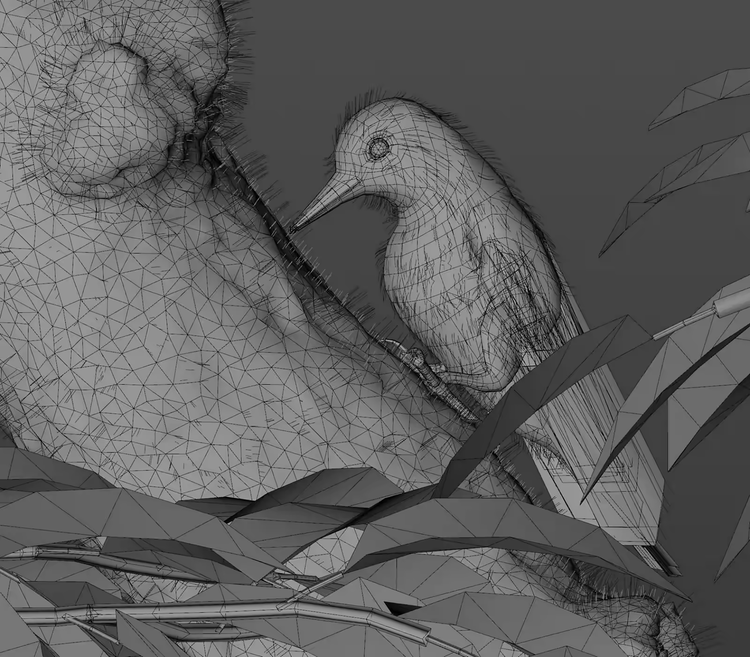What is a polygon in 3D modeling?
Polygons are 2D shapes that are used to create 3D meshes. Did you ever make those paper cutouts that turned into shapes like pyramids or cubes in school when learning about 3D shapes? Well, in polygonal modeling, a mesh is just like that.

Polygons are fundamental to 3D modeling.
Pieces of a Polygon.
Vertex
Edge
Face
Create any shape imaginable using polygons.
To illustrate a simple example of polygons and complete 3D models, consider the construction of a basic cube. A cube has six faces, 12 edges, and 8 vertices linked together to create one object. With these basic principles, CG artists can use polygons to create any shape they’d like.
If you look at the mesh, or wireframe of any 3D object, you will see the many polygons wove together to create that shape, from a human face to something born wholly from their imagination.
The difference between high-poly, low-poly, and retopology.
High-Poly
A high-poly model refers to a mesh that was created with extreme detail, and usually no regard for the final poly count. Often, high poly models aren’t designed with polygons at all. Typically, they are sculpted using voxel-based 3D methods.
Think of a single voxel like a pixel in 2D art. Each pixel stores color information. A voxel is no different. It’s a single point that stores relevant 3D information, and each has a place in a three-dimensional grid.
Using these methods allows artists to sculpt 3D objects in real-time. When complete, they can export the 3D model as a mesh, in which case, computer algorithms take care of the polygonal modeling. The results are often impressive, but bloated when polygons are concerned. Hence the name, high poly.
Low-Poly
Retopology
This brings us to retopology: the process of turning a high-poly model into a low-poly one. There are several methods, and various software may even have specific tools available to aid the retopology process. For many artists, this is a necessary step in their workflow.
Most commonly, artists will simplify the topology, but bake the more complex, high-poly version onto the objects surface textures. This way very little detail is lost, despite greatly optimizing a model’s performance.

Image by Olivier Beaugrand.
Simple polygonal modeling techniques you can use.
Extrusion
Subdivision
Subdivision is a useful tool and technique for creating smooth 3D models out of polygons. Take our earlier example of a simple cube that only has six faces. One could subdivide each face of the cube, dividing it into smaller quadrants. For example, an artist could subdivide the cube once vertically, and once horizontally, thus splitting each face into four smaller faces.
Subdivision is a great way to increase poly count while letting a basic shape become the starting point for modeling. In general, subdivision can be completed in two types.
- Uniform subdivision. This is when the entire object is subdivided evenly. This will impact the entire mesh.
- Selective subdivision. In this method of subdividing, the artist only selects a single quadrant, for example one face, and imposes the desired number of subdivisions. The remainder of the mesh is unaffected.
Bevels
On their own, the edges of a model are perfectly sharp. Consider again the cube example, where two faces share an edge. You could manipulate the angle between two faces making it square, obtuse, or acute, but the edge itself would remain sharp.
Beveling tools allow artists to select an edge and then add any number of bevels to soften an edge. This is a useful tool but should be used carefully as it can easily add unwanted polygons or cause conflicts with topology if too much detail is added to one bevel.
Use Adobe Substance 3D to create inspiring art without fussing over polygons.
For many 3D workflows, polygonal modeling may seem unavoidable. Managing topology can feel like a hassle, especially in situations when having a perfectly streamlined mesh may not be required. This is especially the case in product-focused industries that want to take advantage of 3D.
In these situations, having a software that not only allows you to block out shapes quickly and efficiently, but can also produce high-quality results for both hard surface and organic surface modeling, can make all the difference in your success in 3D.
Adobe Substance 3D Modeler is a voxel-based sculpting software that aims to make 3D modeling feel as gestural and natural as working with real clay. From start to finish, artists don’t need to worry about polygons, topology, or UV mapping. All these steps are handled by the software at export, and the artist has export options available to help guide this process.
Discover modeler and the rest of the Substance 3D apps to learn more.
Thank you for exploring the world of Adobe. We can’t wait to see what you create.
